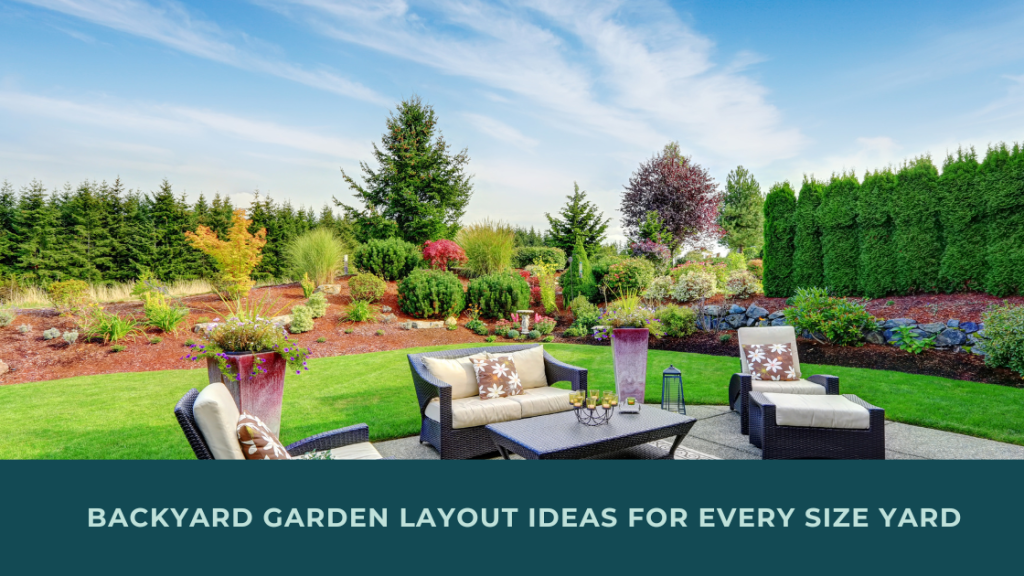Creating a backyard garden is one of the most rewarding home projects you can take on. It’s not just about adding plants; it’s about designing a peaceful, beautiful space that fits your lifestyle and yard size. Whether you have a sprawling backyard or a cozy patio, planning the right backyard garden layout can completely transform your outdoor area into a spot you’ll love spending time in. If you want inspiration or expert tips on getting started, check out this helpful guide on Garden Installation for everything you need to know before digging in.
Planning Your Backyard Garden Layout
Before you start planting, take a moment to visualize your space. The best gardens don’t happen by accident: they come from smart garden arrangement and thoughtful design. Walk around your yard at different times of day to see where the sunlight hits, where shade lingers, and where rainwater collects. These small details can help you figure out what types of plants will thrive and how to position them for balance and beauty.
Think about what kind of vibe you want. Do you imagine a cozy cottage garden filled with color and fragrance, or a sleek, modern design with clean lines and sculpted greenery? Your backyard garden layout should reflect your personal style while also fitting your yard’s natural flow.
Small Yards: Making the Most of Every Inch
If your backyard is on the smaller side, don’t worry: you can still create a lush and inviting garden. The trick is to use height and layering to your advantage. Mix tall plants like ornamental grasses or climbing vines with medium shrubs and low-growing ground covers. This creates depth and texture, making your space look larger than it really is.
Raised beds or vertical planters are also perfect for small gardens. They not only save space but also make maintenance easier. You can plant herbs, flowers, or even small vegetables without feeling cramped. And for an extra touch of charm, use stepping stones or a narrow gravel path to guide the eye and define your garden arrangement.
Medium Yards: Balance and Flow
If you have a medium-sized yard, you’ve got plenty of creative freedom. Try dividing your garden into distinct zones; like a dining area, a flower garden, and a small vegetable patch. Use hedges, small fences, or even potted plants to subtly separate each area without making the space feel closed off.
A central feature like a birdbath, water fountain, or garden bench can create a natural focal point. Position it so it catches the eye from your patio or main seating area. Then, plan your backyard garden layout around it, letting your plants and pathways draw attention to that central piece.
Large Yards: Go Big with Design
A big backyard opens the door to endless garden installation ideas. You can include winding paths, shaded seating spots, flower beds, and even a small pond or pergola. Large yards benefit from layering not just in height but also in distance. Plant larger shrubs and trees toward the back and smaller ones near the front to create depth and balance.
Don’t try to fill every inch of space with plants. Leave some open areas for grass or gravel to give your garden room to breathe. If you love entertaining, consider adding a patio or outdoor kitchen surrounded by lush greenery. A well-planned garden arrangement turns your yard into a relaxing retreat that feels both natural and intentional.
Choosing the Right Plants for Your Layout
The key to a thriving garden isn’t just the design it’s choosing plants that work for your environment. Think about your climate, soil type, and how much time you want to spend on maintenance. Native plants are a great choice because they’re adapted to local conditions and usually require less care.
For visual appeal, mix perennials (plants that come back every year) with annuals (plants that bloom for one season). This balance keeps your garden looking lively and colorful throughout the year. Add texture by combining different leaf shapes, colors, and sizes. Even a simple backyard garden layout can look stunning when you play with contrast and variety.
Adding Pathways and Features
A good pathway can completely change how your garden feels. Stone, gravel, or brick paths not only guide movement but also add charm and structure. Curved pathways give a more natural flow, while straight ones create a formal, clean look.
If you have the space, consider adding a few standout features like a pergola, trellis, or small seating nook. These focal points invite you to spend more time outside and make your garden feel like an extension of your home.
Lighting and Finishing Touches
Lighting is often overlooked, but it’s the secret to enjoying your garden after sunset. Soft, warm lights along pathways or under trees can make your space look magical at night. Solar lights are eco-friendly and easy to install, while string lights add a cozy, romantic glow.
Finally, think about personal touches: like decorative pots, garden art, or a hammock. These details make your garden arrangement unique and reflect your personality.
Maintaining Your Garden
Even the best-designed garden needs a little love to stay beautiful. Regular watering, pruning, and weeding will keep everything looking fresh. Use mulch to help retain moisture and control weeds. It’s also a good idea to check your plants occasionally for pests or diseases. A little maintenance goes a long way in keeping your garden healthy and inviting.
Wrapping It Up
Whether you have a tiny patio garden or a large backyard oasis, the secret to a great backyard garden layout is planning and creativity. Think about how you’ll use the space, choose plants that fit your environment, and don’t forget to leave room for yourself to relax and enjoy it. For more inspiration, design ideas, and professional advice, take a look at Garden Installation and start planning your outdoor sanctuary today. With the right setup, even the smallest yard can become your favorite place to unwind.



